
Score breakdown
Things we like
- Modern, intriguing looks
- Low-down tractability
- Excellent value
Not so much
- Stiff ride
- Highway wind noise
- Basic infotainment software
The Ssangyong Korando has come a long way since it first debuted here in 1998. In contrast to that second-generation model’s, erm, interesting looks, our fourth-generation Korando ELX is striking. Handsome, even.
Of course, the Korando needs to stand out in the fiercely competitive medium SUV segment. Especially if it wants to pull its weight in Ssangyong’s lean model portfolio. Currently, the Musso pick-up ute and seven-seat Rexton SUV are outselling the urban soft-roader by a factor of at least two to one.
The Korando has more than looks to help. Not only is it the cheapest mid-size SUV on the market, beginning at just $26,990 before on-road costs for the base EX with a manual transmission, but the range also begins with a turbocharged 1.5-litre petrol engine.
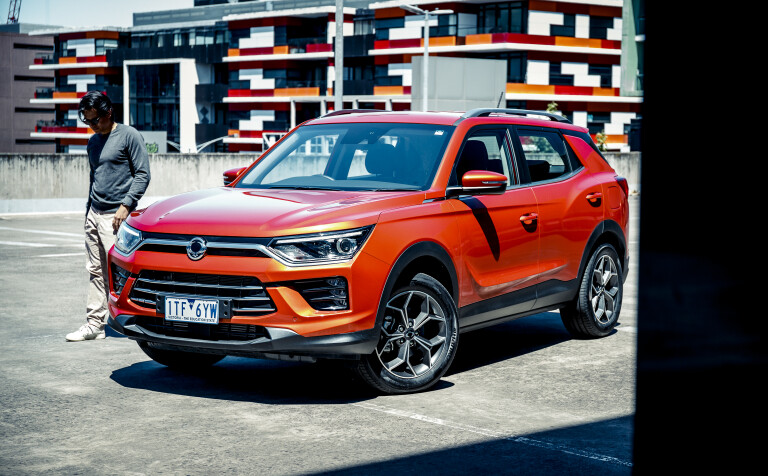
For its segment, the Korando’s five-door body fares on the smaller side but accommodates five with decent room – a point we’ll get to later. At 4450mm long, it sits between a Skoda Karoq and Toyota RAV4 for length. Meanwhile, its kerb weight is near-average at 1469kg.
Released in 2019, the fourth-generation Korando drives only the front wheels in most variants, while AWD is available on the top-spec Ultimate with the 2.0-litre diesel.
Choosing the ELX trim adds small touches of luxury to the Korando’s interior and exterior while upgrading its safety hardware. Gone are the oxymoronic luxury cloth seats in the ELX, replaced with fabric seats that feature synthetic leather bolsters. They’re also heated.
The Korando has more than looks to help. Not only is it the cheapest mid-size SUV, but the range also begins with a turbocharged 1.5-litre petrol engine.

The seats are complemented by leather trim on the steering wheel and gear selector. Extra modern conveniences on the ELX include a smart key and doors that automatically lock at a certain speed or when you walk away, as well as an electric handbrake and steering column lock.
Outside, the ELX wears special LED daytime running lights in its front bumper that match highlighted slats in the front grille. It also scores 18-inch wheels (up from 17s) and metal roof rails.
All Korandos received a five-star ANCAP safety rating in 2019, thanks in part to standard-fit AEB and lane-keeping technologies. The ELX introduces blind spot detection with lane change assist, rear cross-traffic alert and exit assist. There’s also an auto vehicle hold for inclines and parking sensors at both ends to augment the rear-view camera.

All up, an ELX adds $4000 to an EX auto, coming in at $32,990 drive-away. Add $495 for metallic paint, which our tester wears in Orange Pop. Ssangyong sweetens the deal with an impressive seven-year, unlimited distance warranty backed by fixed-price servicing (every 12 months or 15,000km) and roadside assistance.
ADR combined fuel consumption is rated at 7.7L/100km, but the ELX drank 8.8L/100km in our care over a mixed test route that included brief hard driving. At that level of consumption, you should extract more than 500km of range from its 47L tank. Just remember the Korando’s turbo motor requires 95 RON at a minimum.
High-quality fuel plays some part in the 120kW/280Nm engine’s hardworking nature. The torque peak arrives as early as 1500rpm and lasts until 4000rpm, making the Korando tractable from low in the rev range, often chirping the front wheels off the line under full throttle. But it’s a shame the transmission blunts the engine’s potential.
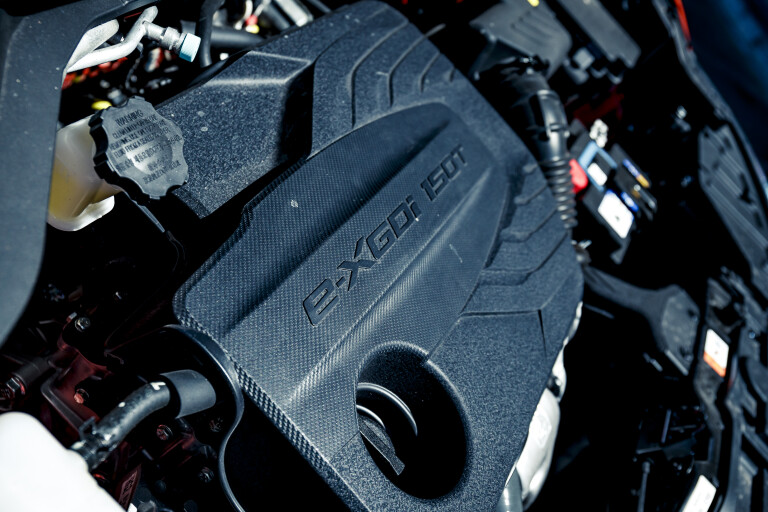
The six-speed automatic is a smooth shifter most of the time. In hurried situations, though, the gearbox can forget to upshift out of a low gear, and it’s very cautious about manually downshifting into second from third at more than 2750rpm.
Our biggest gripe with the transmission lies with its mapping. It’s determined to upshift and keep the engine under 2000rpm, even in Sport Mode, and the kick-down detente being set low to the floor also exacerbates the frustration.
The Korando is tractable from low down in the rev range but it’s a shame the transmission blunts the engine’s potential.

Fully pinned, the ELX’s engine loses enthusiasm above 5000rpm and upshifts well before a redline that begins at 6500rpm. Ultimately, the Korando accelerates to 100km/h from rest in 9.18sec, dispatching the 80-120km/h sprint in a respectable 6.89sec.
The engine isn’t musical sounding, either, but thankfully the cabin is quite well insulated.
Dynamically the ELX is a mixed bag. The Korando rides on fixed-rate dampers, 235mm-wide tyres with chunky sidewalls and the suspension layout is MacPherson strut front with a multi-link rear. It easily handles urban roads with its 10.7m turning circle and direct steering rack (at 2.8 turns lock to lock).
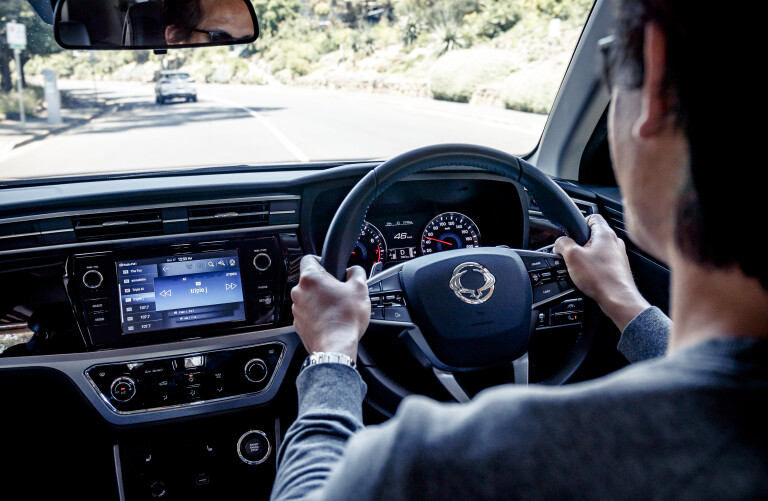
Out on country roads, the Korando struggles to settle on anything less than a smooth surface. At the same time, its roadholding – for all its stiffness over imperfections – is easily flustered by hard direction changes.
Mid-corner bumps easily provoke a secondary movement from the Korando, sapping confidence in its ability to hold your intended cornering line. We’d also appreciate more feedback at the top of the brake’s pedal travel, which feels spongy.
Out on country roads, the Korando struggles to settle on anything less than a smooth surface. At the same time, its roadholding is easily flustered by hard direction changes.

Otherwise, the Korando wins back points on interior packaging. The front seating position is set at a perfectly judged height for an SUV, while interior ergonomics place most touchpoints within easy reach. Two small markdowns include the central transmission tunnel that eats into legroom and a central storage box that reduces elbow room, but there’s plenty of headroom.
The front workstation is cohesively styled, with air vents well integrated into design features and the central console providing a straightforward layout. Standard smartphone mirroring saves you from the media screen’s patchy and bland infotainment software, but its touch functionality would benefit from a screen larger than 8.0-inches.
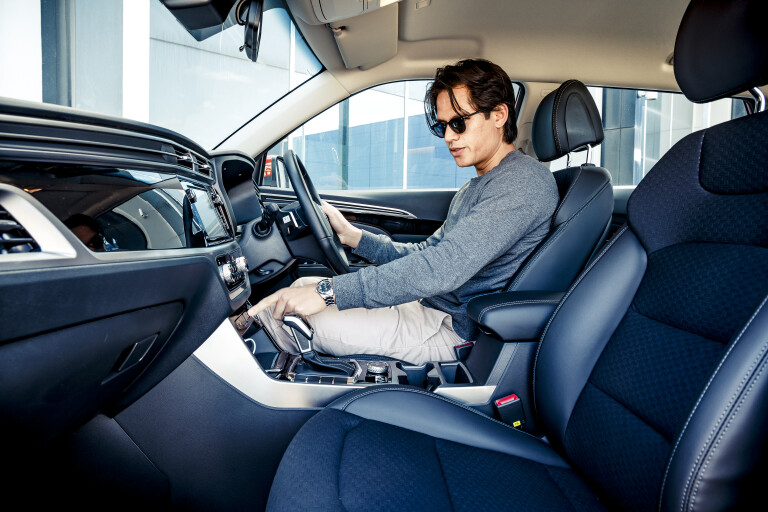
But the driver’s seat squab is undersized and on long trips, the bolsters quickly grow uncomfortable against your thighs. Elsewhere, the geometric gear knob’s hard corners feel unwelcome in the hand but the egg-shaped steering wheel is a delight and allows good visibility of the column stalks and dash.
What the rear quarters lack in equipment, they make up with decent room for heads knees and feet. A wide trans tunnel will make the centre passenger’s life tricky when placing their feet, though. Child seat ISOFIX points feature on the outboard seats.
Outward vision forward of the B-pillars is good. Still, the Korando’s C-pillars create a large over-shoulder blind spo\t that would be odious without the ELX’s blind-spot monitoring system, which does a good job of detecting vehicles approaching from far back.

Speaking of highway safety, the lane-keeping system is tuned well, gently steering the Korando away from the edges of your lane with no pinballing effect. We only wish the steering itself was as sharp as it struggles for accuracy and feedback.
Wind noise is loud at highway speeds. And even though the six-speaker stereo offers good sound clarity, it lacks the power or bass to mask the wind and road noise.
The absence of adaptive cruise control is noticeable among other active safety features but symbolises the Korando’s urban-focused nature. With a flat loading floor that hides a full-size spare, its rear boot swallows 551L with the rear seats up or 1248L with them down.
All up, the Korando ELX has a lot going for it. As one of the cheaper SUVs on sale, its strong ownership package and crucial safety features help soothe the pain of its flaws.
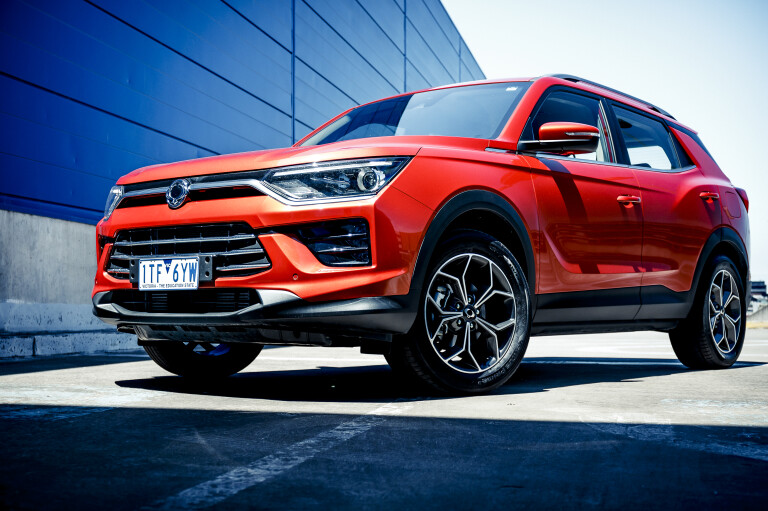
All up, the Korando ELX has a lot going for it. As one of the cheaper mid-size SUVs on sale, its strong ownership package, good looks, low-down torque and crucial safety features help soothe the pain of its flaws.
Unfortunately, though, there are many of those. The hard ride spoils its town manners, while sub-par NVH levels and undersized seats knock down its touring credibility.
As such, the Korando is appealing on some key attributes but sometimes it shows you do get what you pay for.
2021 SsangYong Korando ELX specifications
| Body | 5-door, 5-seat SUV |
|---|---|
| Layout | front-engine (east-west), FWD |
| Engine | 1497cc inline 4cyl, DOHC, 16v, turbo |
| Outputs | 120kW @5500rpm / 280Nm @1500-4000rpm |
| Transmission | six-speed automatic |
| Weight | 1469kg |
| Towing | 500kg unbraked / 1500kg braked (diesel 750/2000) |
| Fuel tank | petrol / 47L (95 RON) |
| Boot | 551L (VDA)/1248L (VDA) |
| Spare tyre | full-size |
| L/W/H/WB | 4450/1870/1620/2675 |
| Suspension | Struts (f); multi-links (r) |
| Tyre sizes | 235/55 R18 |
| Turning circle | 10.7m |
| Lock-to-lock | 2.8 turns |
| Brakes | ventilated (f); solid (r) |
| Consumption (combined ADR) | 7.7L/100km |
| ANCAP | five stars (2019) |
| Price | $32,990 drive-away |
| Price as tested | $33,485 drive-away *Orange pop metallic paint |
| 0-100km/h | 9.18sec |
| 80-120km/h | 6.89sec |
| L/100km | 8.8L/100km |
Score breakdown
Things we like
- Modern, intriguing looks
- Low-down tractability
- Excellent value
Not so much
- Stiff ride
- Highway wind noise
- Basic infotainment software

COMMENTS